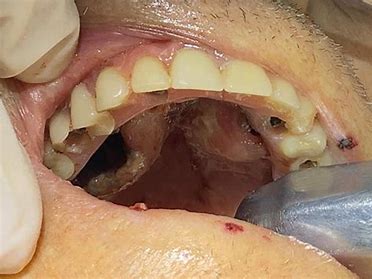Treatment of Oral Myiasis in a Patient with Implant-Supported Fixed Prosthesis

Oral myiasis, a rare parasitic infection caused by fly larvae, can be a serious medical condition when occurring in the oral cavity. While more common in individuals with poor oral hygiene, compromised immune systems, or in regions with limited healthcare access, it presents unique challenges when diagnosed in patients with implant-supported fixed prostheses.
Case Overview: In the case of a patient with an implant-supported fixed prosthesis, the treatment of oral myiasis requires a delicate, multidisciplinary approach. The prosthesis often complicates the infection, as it may create areas for larvae to hide and make mechanical cleaning difficult. Early diagnosis is critical for managing the condition before it leads to extensive tissue damage, bone involvement, or implant failure.

Treatment Process:
- Mechanical Removal: The initial step involves the careful mechanical removal of the larvae using forceps under local anesthesia. The prosthesis might need to be temporarily removed to access infected areas and perform thorough debridement.
- Irrigation and Disinfection: After mechanical removal, the affected area is irrigated with antiseptic solutions like hydrogen peroxide or saline to ensure that all larvae and debris are cleared. Antiseptic mouth rinses may also be prescribed to control secondary infections.
- Pharmacological Treatment: The administration of systemic ivermectin or other antiparasitic drugs can help eliminate any remaining larvae. Antibiotics are often prescribed to prevent bacterial infection in the damaged tissue.
- Prosthesis Re-evaluation: After the active infection is controlled, the prosthesis should be carefully examined for any structural damage or contamination. Further prosthodontic treatment may be necessary if the implants or supporting structures were compromised.
Follow-up Care: Regular follow-up appointments are crucial to monitor healing and ensure that no reinfection occurs, particularly in patients with underlying conditions or poor hygiene.





